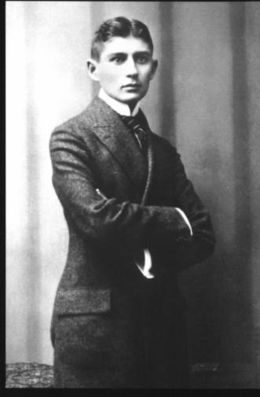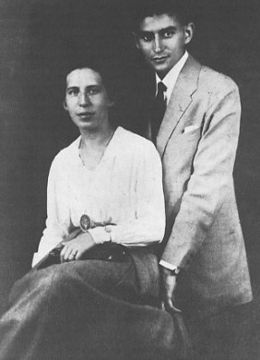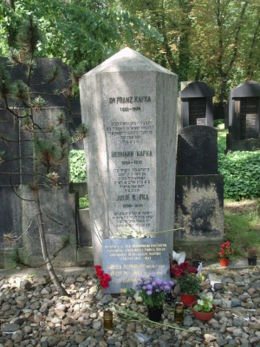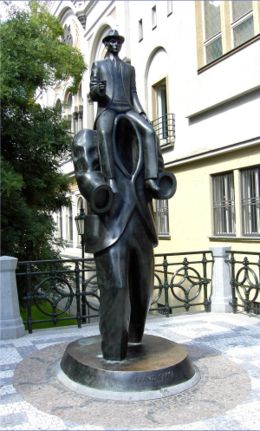Franz Kafka
2007 Schools Wikipedia Selection. Related subjects: Writers and critics
 Photograph of Franz Kafka taken in 1917 |
|
| Born: | July 3, 1883 Prague, Austria-Hungary (today in the Czech Republic) |
|---|---|
| Died: | June 3, 1924 Vienna, Austria |
| Occupation(s): | insurance officer, factory manager, novelist, short story writer |
| Nationality: | Ashkenazi Jewish- Bohemian ( Austria-Hungary) |
| Genre(s): | novel, short story |
| Literary movement: | modernism, existentialism, Surrealism, precursor to magical realism |
| Influences: | Søren Kierkegaard, Fyodor Dostoevsky, Charles Dickens, Friedrich Nietzsche |
| Influenced: | Albert Camus, Federico Fellini, Isaac Bashevis Singer, Jorge Luis Borges, Gabriel Garcia Marquez, Carlos Fuentes, Salman Rushdie, Haruki Murakami |
Franz Kafka ( IPA: [ˈfranʦ ˈkafka]) ( July 3, 1883 – June 3, 1924) was one of the major German-language novelists and short story writers of the 20th century, whose unique body of writing — much of it incomplete, and published posthumously despite his wish that it be destroyed — has become considered amongst the most influential in Western literature.
His most famous pieces of writing include his short story Die Verwandlung ( The Metamorphosis) and his unfinished novel Das Schloß ( The Castle). The adjective " kafkaesque" has come into common use to denote mundane yet absurd and surreal circumstances of the kind commonly found in Kafka's work.
Life
Family
Kafka was born into a middle-class, German-speaking Jewish family in Prague, the capital of Bohemia, a kingdom that was then part of the Austro-Hungarian Empire. His father, Hermann Kafka (1852–1931), was described as a "huge, selfish, overbearing businessman" (Corngold 1972) and by Kafka himself as "a true Kafka in strength, health, appetite, loudness of voice, eloquence, self-satisfaction, worldly dominance, endurance, presence of mind, [and] knowledge of human nature ..." . Kafka struggled to come to terms with his domineering father. Hermann was the fourth child of Jacob Kafka, a butcher, and came to Prague from Osek, a Jewish village near Písek in southern Bohemia. After working as a traveling sales representative, he established himself as an independent retailer of men's and women's fancy goods and accessories, employing up to 15 people and using a jackdaw (kavka in Czech) as his business logo. Kafka's mother, Julie (1856—1934), was the daughter of Jakob Löwy, a prosperous brewer in Poděbrady, and was better educated than her husband.
Kafka was the eldest of six children. He had two younger brothers, Georg and Heinrich, who died at the ages of fifteen months and six months, respectively, before Kafka was six, and three younger sisters, Gabriele ("Elli") (1889–1941), Valerie ("Valli") (1890–1942), and Ottilie ("Ottla") (1892–1943). On business days, both parents were absent from the home. His mother helped to manage her husband's business and worked in it as much as 12 hours a day. The children were largely reared by a succession of governesses and servants.
Kafka's sisters were sent with their families to the Łódź ghetto and died there or in concentration camps. Ottla is believed to have been sent to the concentration camp at Theresienstadt and then to the death camp at Auschwitz.
Education
Kafka learned German as his first language, but he was also almost fluent in Czech. Later, Kafka also acquired some knowledge of French language and culture; one of his favorite authors was Flaubert. From 1889 to 1893, he attended the Deutsche Knabenschule, the boys' elementary school at the Fleischmarkt (meat market), the street now known as Masná Street in Prague. His Jewish education was limited to his Bar Mitzvah celebration at 13 and going to the synagogue four times a year with his father. After elementary school, he was admitted to the rigorous classics-oriented state gymnasium, Altstädter Deutsches Gymnasium, an academic secondary school with eight grade levels, where German was also the language of instruction, at Staroměstské náměstí, within the Kinsky Palace in the Old Town. He completed his Matura exams in 1901.
Admitted to the Charles University of Prague, Kafka first studied chemistry, but switched after two weeks to law. This offered a range of career possibilities, which pleased his father, and required a longer course of study that gave Kafka time to take classes in German studies and art history. At the university, he joined a student club, named Lese- und Redehalle der Deutschen Studenten, which organized literary events, readings and other activities. In the end of his first year of studies, he met Max Brod, who would become a close friend of his throughout his life, together with the journalist Felix Weltsch, who also studied law. Kafka obtained the degree of Doctor of Law on June 18, 1906 and performed an obligatory year of unpaid service as law clerk for the civil and criminal courts.
Work
On November 1, 1907, he was hired at the Assicurazioni Generali, an aggressive Italian insurance company, where he worked for nearly a year. His correspondence, during that period, witnesses that he was unhappy with his working time schedule - from 8 p.m until 6 a.m - as it made it extremely difficult for him to concentrate on his writing. On July 15, 1908, he resigned, and two weeks later found more congenial employment with the Worker's Accident Insurance Institute for the Kingdom of Bohemia. He often referred to his job as insurance officer as a "Brotberuf", literally "bread job", a job done only to pay the bills. However, he did not show any signs of indifference towards his job, as the several promotions that he received during his career prove that he was a hard working employee. A little known fact about this period, reported by Peter Drucker in Managing in the Next Society, is that Kafka invented the safety helmet. He received a medal for this invention in 1912 because it reduced Bohemian steel mill deaths to fewer than 25 per thousand employees. (He was also given the task of compiling and composing the annual report and was reportedly quite proud of the results, sending copies to friends and family.) In parallel, Kafka was also committed to his literary work. Together with his close friends Max Brod and Felix Weltsch these three were called "Der enge Prager Kreis", the close Prague circle.
In 1911, Karl Hermann, spouse of his sister Elli, proposed Kafka collaborate in the operation of an asbestos factory known as Prager Asbestwerke Hermann and Co. Kafka showed a positive attitude at first, dedicating much of his free time to the business. During that period, he also found interest and entertainment in the performances of Yiddish theatre, despite the misgivings of even close friends such as Max Brod, who usually supported him in everything else. Those performances also served as a starting point for his growing relationship with Judaism.
Later years
In 1912, at the home of his lifelong friend Max Brod, Kafka met Felice Bauer, who lived in Berlin and worked as a representative for a dictaphone company. Over the next five years they corresponded a great deal, met occasionally, and twice were engaged to be married. Their relationship finally ended in 1917.
In 1917, Kafka began to suffer from tuberculosis, which would require frequent convalescence during which he was supported by his family, most notably his sister Ottla. Despite his fear of being perceived as both physically and mentally repulsive, he impressed others with his boyish, neat, and austere good looks, a quiet and cool demeanor, obvious intelligence and dry sense of humor .
In the early 1920s he developed an intense relationship with Czech journalist and writer Milena Jesenská. In 1923, he briefly moved to Berlin in the hope of distancing himself from his family's influence to concentrate on his writing. In Berlin, he lived with Dora Diamant, a 25-year-old kindergarten teacher from an orthodox Jewish family, who was independent enough to have escaped her past in the ghetto. Dora became his lover, and influenced Kafka's interest in the Talmud .
It is generally agreed that Kafka suffered from clinical depression and social anxiety throughout his entire life. He also suffered from migraines, insomnia, constipation, boils, and other ailments, all usually brought on by excessive stresses and strains. He attempted to counteract all of this by a regimen of naturopathic treatments, such as a vegetarian diet and the consumption of large quantities of unpasteurized milk (the latter possibly the cause of his tuberculosis ). However, Kafka's tuberculosis worsened; he returned to Prague, then went to a sanatorium near Vienna for treatment, where he died on June 3, 1924, apparently from starvation. The condition of Kafka's throat made it too painful to eat, and since intravenous therapy had not been developed, there was no way to feed him (a fate resembling that of Gregor in the Metamorphosis and the main character of A Hunger Artist). His body was ultimately brought back to Prague where he was interred on June 11, 1924, in the New Jewish Cemetery in Prague-Žižkov.
Personal views
Kafka maintained his indifference to formal religion throughout most of his life. Yet, while never depicting the characters in his stories as Jewish, he never tried to obfuscate his Jewish roots. Intellectually, Hasidism held a strong appeal for him, especially because of the value it places in transcendent, mystical experience. During the last ten years of his life, Kafka even professed an interest in moving to Palestine. The ethical and procedural dilemmas presented in " The Judgment," " The Stoker," " A Hunger Artist," and " A Country Doctor all bear distinct traces of Kafka's interest in rabbinical teachings as they pertain to law and justice. The humorously meticulous style of the argumentative narrator in " Josephine the Singer," on the other hand, shadows the rhetorical conventions of rabbinical discource.
Literary work
Kafka published only a few short stories during his lifetime, a small part of his work, and never finished any of his novels (with the possible exception of The Metamorphosis, which some consider to be a short novel). His writing attracted little attention until after his death. Prior to his death, he instructed his friend and literary executor Max Brod to destroy all of his manuscripts. His lover, Dora Diamant, partially executed his wishes, secretly keeping up to 20 notebooks and 35 letters until they were confiscated by the Gestapo in 1933. An ongoing international search is being conducted for these missing Kafka papers. Brod overrode Kafka's instructions and instead oversaw the publication of most of his work in his possession, which soon began to attract attention and high critical regard.
All of Kafka's published works, except several letters he wrote in Czech to Milena Jesenská, were written in German.
Style of writing
Born in Prague, Kafka was fluent in Czech, but chose to write in Prager Deutsch ( Prague German), the dialect spoken by the German-Jewish and -Christian minorities in the Bohemian capital. Prague German, he felt, was more "truthful" than High German: Using it skillfully, he was able to make it work for him in a way that was purely his own.
Writing in German, which allows for rambling nonstop sentences that are capable of possessing an entire page, Kafka's stories often pack an unexpected punch just before the period—that punch being the finalizing meaning and focus. The reader discovers what Gregor Samsa has become, thanks to the past participle that procedes the period, verwandelt (transformed).
Another virtually insurmountable problem facing the translator is how to deal with the author's intentional use of ambiguous terms or of words that have several meanings. An example is the Kafka's use of the German noun Verkehr in the final sentence of The Judgment. The sentence can be translated as: "At that moment an unending stream of traffic crossed over the bridge." What gives added weight to the obvious double meaning of Verkehr is Kafka's confession to his friend and biographer Max Brod that when he wrote that final line, he was thinking of "a violent ejaculation." In the English translation, of course, what can Verkehr be but "traffic"?
Critical interpretation
Many critics have tried to make sense of Kafka's works by interpreting them through certain schools of literary criticism such as modernism, magical realism, and so on . The apparent hopelessness and the absurdity that seem to permeate his works are considered emblematic of existentialism. Others have tried to locate a Marxist influence in his satirization of bureaucracy in pieces such as In the Penal Colony, The Trial, and The Castle, whereas others point to anarchism as an inspiration for Kafka's anti-bureaucratic viewpoint. Still others have interpreted his works through the lens of Judaism (Borges made a few perceptive remarks in this regard), through Freudianism (because of his familial struggles), or as allegories of a metaphysical quest for God ( Thomas Mann was a proponent of this theory).
Themes of alienation and persecution are repeatedly emphasized, and the emphasis on this quality, notably in the work of Marthe Robert, partly inspired the counter-criticism of Gilles Deleuze and Felix Guattari, who argued that there was much more to Kafka than the stereotype of a lonely figure writing out of anguish, and that his work was more deliberate, subversive, and more "joyful" than it appears to be.
Furthermore, an isolated reading of Kafka's work — focusing on the futility of his characters' struggling without the influence of any studies on Kafka's life — reveals the humor of Kafka. Kafka's work, in this sense, is not a written reflection of any of his own struggles, but a reflection of how people invent struggles.
Biographers have said that it was common for Kafka to read chapters of the books he was working on to his closest friends, and that those readings usually concentrated on the humorous side of his prose. Milan Kundera refers to the essentially surrealist humour of Kafka as a main predecessor of later artists such as Federico Fellini, Gabriel García Márquez, Carlos Fuentes and Salman Rushdie. For Márquez it was as he said the reading of Kafka's The Metamorphosis that showed him "that it was possible to write in a different way".
Publications and dates
Readers of Kafka should pay particular attention to the dates of the publications (whether German or translated) of his writing when choosing an edition to read.
Kafka died before preparing (in some cases even finishing) some of his writings for publication. Therefore, the novels The Castle (which stopped mid-sentence and had ambiguity on content), The Trial (chapters were unnumbered and some were incomplete) and Amerika (Kafka's original title was The Man who Disappeared) were all prepared for publishing by Max Brod. It appears Brod took a few liberties with the manuscript (moving chapters, changing the German and cleaning up the punctuation) and hence the original German text, that was not published, was altered. The editions by Brod are generally referred to as the Definitive Editions.
According to the publisher's note for The Castle ( Schocken Books, 1998), Malcolm Pasley was able to get most of the Kafka's original handwritten work into the Oxford Bodleian Library in 1961. The text for The Trial was later acquired through auction and is stored at the German literary archives at Marbach, Germany (publisher's note, The Trial, Schocken Books, 1998).
Subsequently, Pasley headed a team (including Gerhard Neumann, Jost Schillemeit, and Jürgen Born) in reconstructing the German novels and S. Fischer Verlag republished them. Pasley was the editor for Das Schloß (The Castle), published in 1982, and Der Prozeß (The Trial), published in 1990. Jost Schillemeit was the editor of Der Verschollene ( Amerika) published in 1983. These are all called the 'Critical Editions' or the 'Fischer Editions'. The German critical text of these, and Kafka's other works, may be found online at The Kafka Project .
Translations
There are two primary sources for the translations based on the two German editions. The earliest English translations were by Edwin and Willa Muir and published by Alfred A. Knopf. These editions were widely published and spurred the late-1940's surge in Kafka's popularity in the United States. Later editions (notably the 1954 editions) had the addition of the deleted text translated by Eithne Wilkins and Ernst Kaiser. These are known 'Definitive Editions'. They translated both The Trial, Definitive and The Castle, Definitive among other writings. Definitive Editions are generally accepted to have a number of biases and to be dated in interpretation.
After Pasley and Schillemeit completed their recompilation of the German text, the new translations were completed and published -- The Castle, Critical by Mark Harman ( Schocken Books, 1998), The Trial, Critical by Breon Mitchell ( Schocken Books, 1998) and Amerika: The Man Who Disappeared by Michael Hoffman ( New Directions Publishing, 2004). These editions are often noted as being based on the restored text.
Trivia
- In a letter to his friend and publisher Kurt Wolff, Kafka wrote that he wished to include " The Judgment," " The Stoker", and " The Metamorphosis" in one volume under the title The Sons. This letter is dated April 4, 1913&madash;well before he had written either "The Stroker" or "The Metamorphosis."
- In Mexico, this phrase is commonly used in printed media (newspapers) and digital media (blogs, forums) to tell how hopeless and absurd the country is: "Si Franz Kafka fuera mexicano, sería costumbrista" (If Franz Kafka were Mexican, he would be a Costumbrista writer).
- The influential Scottish post-punk group Josef K was named after the protagonist in Kafka's novel The Trial, as band leader Paul Haig was a Kafka fan who considered himself an existentialist.
- Nobel Prize winner Isaac Bashevis Singer wrote a short story called A Friend of Kafka, which was about a Yiddish actor called Jacques Kohn who said he knew Franz Kafka. In this story, according to Jacques Kohn, Kafka believed in the Golem, a legendary creature from Jewish folklore.
Online texts
- Works by Franz Kafka at Project Gutenberg
- The Kafka Project Project initiated in 1998 with the purpose of publishing online all Kafka texts in German, in the form of the manuscripts




